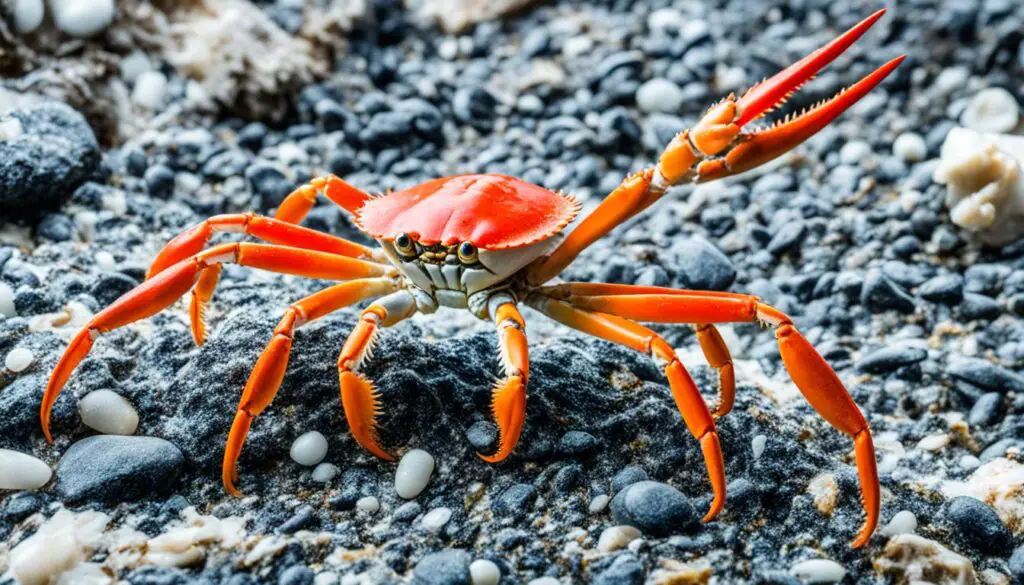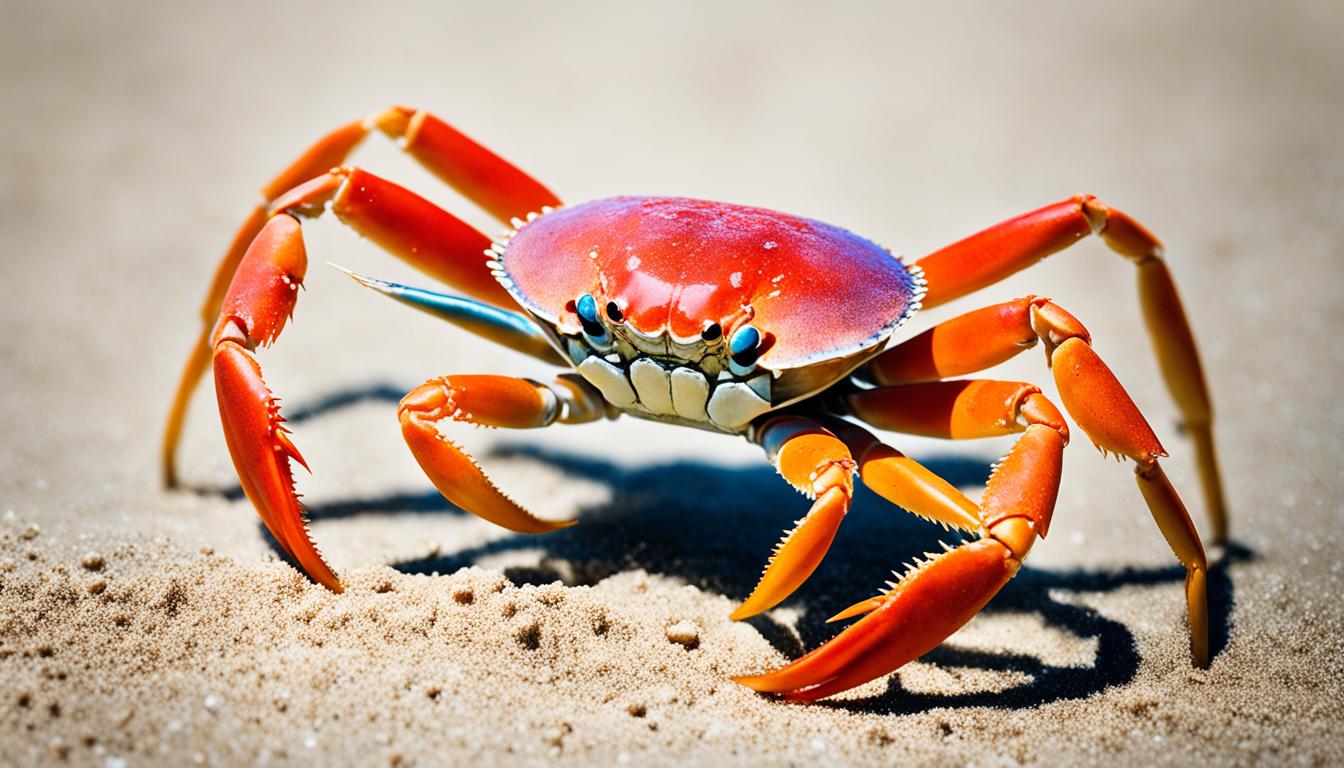Exploring how crabs move is truly captivating. It shows us the amazing ways these creatures move. Their unique moves are shaped by their body structure and evolution. Crabs use their special way of moving for things like finding food, avoiding danger, and moving through different places.
By looking at their body parts and how they move, we can understand their crab behavior. We also see how their environment affects their movements.
Understanding Crab Locomotion
Crab locomotion is a fascinating phenomenon. It’s influenced by their unique body structure and joint mechanics. Their anatomy shows how they move through their environments effectively.
Characteristics of Crab Bodies
The crab body structure is wide and flat, perfect for burrowing in sand. This shape lets crabs fit into small spaces, helping them survive and hunt. Their bodies are adaptable, making them successful in both land and water.
The Role of Joint Flexibility
Joint flexibility is key to crab movement. Their leg joints work like simple hinges, allowing limited backward motion. This crab joint structure helps them move sideways quickly. It’s crucial for escaping danger and shows how joint design aids their survival.
| Feature | Function | Impact on Locomotion |
|---|---|---|
| Body Shape | Wide and flattened | Facilitates burrowing and compact movement |
| Joint Structure | Hinge-like joints | Enables lateral movement and quick escapes |
| Joint Flexibility | Limited backward motion | Allows for precise agility |
Understanding these elements shows how crab anatomy and movement work together. They support their unique lifestyle and survival in different environments.
How do crabs move?
Crabs move in ways that connect to their history and how they’ve adapted. Their movement has changed from being mostly in water to moving on land. This change made their way of moving more efficient.
The Evolution of Crab Movement
Crabs started moving differently from ancient crustaceans that used their tails a lot for swimming. Over time, their tails became less important. This change led to sideways walking, which helped them move on land and in shallow water better.
This new way of moving made them better at finding food and avoiding predators.
Sideways Walking Technique
Most crabs walk sideways because of how their legs and bodies are shaped. This helps them move quickly sideways, which is great for avoiding predators. The ghost crab is a good example of how fast and agile crabs can be on sandy beaches.
Even though different crabs move in their own ways, they all use sideways movement to survive.
| Feature | Traditional Crustacean | Modern Crab |
|---|---|---|
| Movement Style | Forward swimming | Sideways walking |
| Body Structure | Long tail | Reduced tail, adapted for land |
| Locomotion Efficiency | Slower, less agile | Faster, highly agile |
| Predator Evasion | Vulnerable during movement | Rapid escape through lateral movement |
Different Types of Crab Movement Patterns
Crabs show many ways of moving, based on their type and body shape. Most move sideways, but some go forward. This choice helps them move better in different places. It shows how crabs adapt to their environments.
Sideways vs. Forward Movement
Crabs move sideways often, which helps them cross rough ground quickly. This fits their body shape well. Some, like spider crabs and hermit crabs, can walk forward too. This slower way of moving is important for finding food and staying safe.
Species-Specific Movement Styles
Crabs have different ways of moving, based on their bodies and how they evolved. For example, some crabs can move forward really well. These differences show how crabs adapt to their homes and survive.
| Crab Type | Common Movement Pattern | Efficiency | Special Adaptations |
|---|---|---|---|
| Blue Crab | Sideways | High | Streamlined body for quick navigation |
| Spider Crab | Forward | Moderate | Long legs for stability |
| Hermit Crab | Forward | Low | Adapted shell for protection |
| Raninids | Forward | High | Unique limb structure for propulsion |
Anatomy of Crabs for Efficient Movement
The anatomy of crabs is key to their movement skills. It helps them move well and survive in their world. By looking at crab leg structure and body shape, we learn a lot about how they move.
Leg Structure and Functionality
The crab leg structure is made for better movement and defense. Each leg has many joints for great motion, important for moving over different grounds. The front legs are special, used for grabbing and defending against predators. The other legs help keep the crab stable while it moves, making their movement efficient.
Body Shape and Its Impact on Locomotion
The body shape influence on how crabs move is big. Crabs have flat bodies that let them fit into small spaces and adjust to their surroundings. This shape, along with their quick legs, makes them more mobile and ready to respond to dangers. This shows how important structure and function are for crabs’ survival.

Crab Walking Techniques Explained
Crabs have unique ways of walking that help them survive and move around. They use slow shuffling to find food and be careful. But when danger comes, they move fast to get away. This shows how they can change their walking style for different situations.
Slow Shuffling vs. Fast Movement
Slow shuffling helps crabs look for food without making noise or disturbing the ground. On the other hand, fast crab movement is used to escape danger quickly. Their flexible joints let them move fast, showing how their body is built for speed.
Utilization of Front Legs for Defense
Crabs use their front legs for more than just walking. These legs are key in front legs defense, helping them protect themselves from predators. They also help crabs grab food, showing how important these legs are for their survival. Using their body parts wisely helps them stay fit and adaptable in the wild.
| Movement Type | Speed | Purpose | Key Adaptation |
|---|---|---|---|
| Slow Shuffling | Low to Moderate | Foraging, Navigation | Energy Conservation |
| Fast Crab Movement | High | Escape from Predators | Joint Flexibility |
Crab Behavior Related to Movement
Crabs move in ways that show their complex behavior and how they interact with their world. They have many movement habits that help them survive. These include finding food, avoiding predators, and socializing with others. Their way of moving lets them live in different places.
Watching how crabs move tells us about their role in nature. For instance, when they look for food, they help the ocean stay healthy. Their digging and burrowing make the soil better for plants to grow. This shows how important their movements are for their environment.
Crabs also show interesting moves during mating and fighting over land. They can move fast to protect their territory or find a mate. These actions show how important moving is for their survival and life in the wild.










